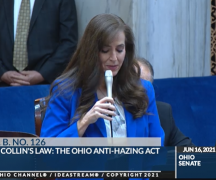By Susan Tebben
While local women’s health clinics are optimistic after President Joe Biden lifted a gag rule on federal funding to abortion-related international organizations, they still want to see domestic funding for abortion providers brought back as well.
Biden rescinded the “Global Gag Rule,” also called the Mexico City Policy, brought in originally by President Ronald Reagan in the 1980s, which said even the mention of abortion services by an non-governmental organizations barred them from receiving funding from the United States.
“These excessive conditions on foreign and development assistance undermine the United States’ efforts to advance gender equality globally by restricting our ability to support women’s health and programs that prevent and respond to gender-based violence,” Biden wrote in the executive order on January 28.
The measure has been a teeter-totter in each political movement since then, which is part of the problem the Ohio chapter of Planned Parenthood had with it.
“Making matters even worse, this damaging, discriminatory policy has gone into and out of effect half a dozen times since it was first implemented,” said Lauren Blauvelt-Copelin, VP of Government Affairs and Public Advocacy for Planned Parenthood Advocates of Ohio. “While we applaud its end, we urge lawmakers to ensure it can never be put in place again.”
While this gag rule only impacts international groups wanting to receive federal funding, there is a domestic gag rule put in effect under President Donald Trump in March 2019. That rule prohibited any Title X Family Planning Program-funded programs from “referring clients for abortion as a method of family planning,” according to the Congressional Research Service. It also requires “physical and financial separation between Title X projects and certain abortion-related activities.”
Title X funding for fiscal year 2020 was $286.5 million, just as it was the year before. The loss of their piece of this funding caused the closure of two Planned Parenthood health centers in Southwest Ohio.
In the same executive order in which Biden rescinded the Mexico City Policy, he ordered a review of Title X “and any other regulations governing the Title X program that impose undue restrictions on the use of federal funds or women’s access to complete medical information.”
The U.S. Secretary of Health and Human Services is tasked with deciding whether to “suspend, revise or rescind” regulations within Title X, according to the order.
The federal regulations are on top of continuing efforts with the Ohio legislature to define and prohibit any kind of abortion services in the state. Most recently, a senate bill passed in December banning the use of telemedicine for medication abortion treatment. State Sen. Theresa Gavarone (R-Bowling Green) was a co-sponsor and voted in favor, and State Rep. Haraz Ghanbari (R-Perrysburg) voted in favor
The law puts a physician at risk of a fourth-degree felony charge for conducting medication abortions or providing abortion-inducing drugs unless they are physically present with the patient. When the bill reached the House floor in December, state Rep. Bill Seitz, the majority floor leader, moved to close debate before debate had even begun, then passed 54-30 along party lines.
Previously in the General Assembly, Senate Bill 27, both Gavarone and Ghanbari were co-sponsors, which requires abortion providers to foot the bill for burial and cremation of fetal remains, passed easily despite arguments that the language of the bill was already a part of state law and already implemented within abortion (and other health) clinics.
During debate on the House floor, then-state Rep. Candice Keller, who co-authored a bill banning abortion completely in the state, said the abortion “industry” should be paying for fetal remain disposal because of their role.
“This industry can afford to bury these babies, and they deserve it, and their mothers deserve it,” Keller said in December.
Anti-abortion lobby group Ohio Right to Life expressed their disappointment in the revocation of the Global Gag Rule, saying women and children “deserve real, life-affirming care and support for the unique challenges they face.”
“This common-sense safeguard has helped protect the conscience rights of millions of Americans and kept the U.S. from enabling big abortion overseas,” said Allie Frazier, director of communications for Ohio Right to Life, in a statement.
***
A year in, DeWine names panel to recommend fixes to Ohio’s unemployment system. What took so long?
Ohio Gov. Mike DeWine on Thursday announced that he’s forming a public-private partnership to recommend improvements to the state’s struggling unemployment system.
That system, operated by the Department of Job and Family Services, has experienced epic problems since the coronavirus pandemic started nearly a year ago.
As with many other states, Ohio’s system was outdated and understaffed when the pandemic hit, DeWine shut down parts of the economy and the federal government passed supplements for the masses who found themselves suddenly out of work.
Desperate Ohioans have faced lengthy waits getting benefits from a system they’d paid into, and some reported hours on hold with overwhelmed call centers. Some who collected benefits were later told, incorrectly, that they needed to repay them. More recently, the system has been inundated by fraudulent claims, again slowing the release of benefits as the creaking system tries to get a handle on the problem. READ MORE
Commentary: When will Ohio spend its “Rainy Day” savings?
In May of 2020, when Ohio had been plunged into recession by the COVID-19 pandemic, state budget analysts were wringing their hands trying to make ends meet in the wake of the worst fiscal crisis since the Great Recession.
Gov. Mike DeWine released a budget plan that month that cut state spending by $775 million dollars, with much of that money coming from state education spending, a sector already reeling from the COVID recession. This all happened while the state budget stabilization fund (often called the “rainy day fund”) sat untapped, $2.7 billion sitting in a state account waiting to be used.
The justification for not using budget stabilization funds, funds saved during strong economic periods to keep the budget going during economic downturns, was that “The ‘rain’ is not a passing spring shower — it could be a long, cold, lingering storm, and we should not use the fund until it is necessary.” Presumably we would need these funds down the road, so we should cut education and health spending now so we can pay for it in the future.
When DeWine released his 2021-2023 budget on Monday, though, plans for the use of the budget stabilization fund over the next two years were made public. The goal for the end of fiscal year 2022? $2.7 billion in the fund. The goal for the end of fiscal year 2023? $2.7 billion in the fund. The same as it was in May of 2020. READ MORE





